Manuscript accepted on : April 28, 2010
Published online on: --
Pharmacognostical Studies on the Aerial Parts of Cocculus Hirsutus (Linn.)
B. Samuel Thavamani1, G. Geetha1and A. Shanish Antony2
1Department of Pharmacognosy, PSG College of Pharmacy, Peelamedu, Coimbatore – 641 004 India.
2Department of Pharmacology, JSS College of Pharmacy, Ooty India.
ABSTRACT: Cocculus hirsutus (Linn.) is a medicinal plant used in various alternative systems of medicine for its hypoglycemic, analgesic and anti-inflammatory activities. Systematic and scientific study of plant drugs may be done by Pharmacognostical, Chemical and Pharmacological studies for the standardization of the herbal plants. In this paper, the aerial parts of Cocculus hirsutus were studied for its macroscopic and microscopic characters which will be a support for the standardization of Cocculus hirsutus.
KEYWORDS: Cocculus hirsutus; Pharmacognostical; Standardization; Microscopical charaters
Download this article as:| Copy the following to cite this article: Thavamani B. S, Geetha G, Antony A. S. Pharmacognostical Studies on the Aerial Parts of Cocculus Hirsutus (Linn.). Biosci Biotech Res Asia 2010;7(1) |
| Copy the following to cite this URL: Thavamani B. S, Geetha G, Antony A. S. Pharmacognostical Studies on the Aerial Parts of Cocculus Hirsutus (Linn.). Biosci Biotech Res Asia 2010;7(1). Available from: https://www.biotech-asia.org/?p=9650 |
Introduction
Menispermaceae, the botanical name for a family of flowering plants, has been universally recognized by taxonomists. It is a medium sized family of 70 generatotalling 420 extant species, mostly of climbing plants. Cissampelos pareira is the climbing plants of this family used for various ailments in Ayurvedic system of medicine.Cissampelos pareriais used in the treatment of indolent ulcers, diarrhoea,urinary tract infection and for its anti-inflammatory property1,2.Cissamperine, Cissampeloflavone are some of the novel chemical components reported in this plant3,4. Because of its wider usage, an attempt was made to study the pharmacognosy of Cissampelos pareira. In this paper a thorough study about the histological characters of the aerial parts of Cisssampelos pareira were carried out.
Materials and Methods
The aerial part of Cissampelos pareira was collected from Kalakadu Hills of Tirunelveli District. The material was fixed in the field of fixative mixture which consists of 70% Ethyl alcohol, Acetic acid and Formalin in the ratio of 90ml, 5ml, 5ml respectively. The materials were left in the fixative for a minium period of 48 hours. Dehydration of the materials was carried out employing tertiary butyl alcohol (TBA) in graded series.Serial microtome sections at 10-12mm thickness were prepared with Rotary Microtome. The sections were stained with Toludine blue as per the schedule suggested by O.Brien et al (1964).Sections were photographed under NIKON Labphot – 2 Photographic unit under different magnifications.
Analytical parameters
The various analytical parameters like moisture content, total ash, acid insoluble ash, water soluble ash, water soluble extractive and alcohol soluble extractive were carried out as per the standard procedures5,6.
Results and Discussion
Macroscopy
Cissampelos pareira is a climbing shrub which is pubescent in nature. Leaves are peltate with the lenght of 3.8-10 cm diametre. Flowers are minute and yellowish. Male flowers are in axillary cymes with peduncle 18 mm long. It has 4 sepals which are hairy and obovate to oblong. Petals combined into a cyathiform corolla which is half the length of the sepals. The filaments are longer than the corolla. Female flowers are elongate, solitary or twin, axillary racemes with very short pedicles; bracts foliaceous or nearly sessile and orbicular or reniform. It has 1 sepal which is ovate to oblong. It has 1 petal which is sub rotund in shape. Fruit is drupe, subglobose, hairy, red, endocarp transversely ridged. The plant is distributed throughout tropical & subtropical India.
Analytical parameters
| S. No | Analytical parameters | Values |
| 1. | Moisture content | 10% w.w |
| 2. | Total ash value | 7.66% w/w |
| 3. | Acid insolubel ash value | 5.33% w/w |
| 4. | Water soluble ash value | 3.33%w/w |
| 5. | Water soluble extractive value | 12.2 w/w |
| 6. | Alcohol soluble extractive value | 8.34 w/w |
Phytochemical tests
Methanolic extracts of the C. pareira when subjected to qualitative chemical tests showed the presence of alkaloids, flavonoids, carbohydrates, glycosides,proteins, gums, mucilage, and phytosterols.
Microscopy
TS of young stem
It shows a single layer of epidermis, many cells of which are elongated to form bi-cellular covering trichomes. The cortex is represented by only 3-5 layers of cells, which are slightly collenchymatous in the outer two layers. Vascular bundles are 5-7 in number and arranged in ring, each is capped by a pericylceand separated by 4-7 cells wide medullary rays, which are parenchymatous and radially elongated, but with age, the outer ray cells and adjoining cortical cells become sclerosed, forming moderately thick walled stone cells. The cells of pericycle gradually become thick walled and lignified in outer 5-7 layers and form sclerenchymatous fibers. The vessels are drum shaped with simple or bordered pits. The central pith is composed of parenchymatous cells which are more or less isodiametric (Fig. 1 and Fig.2).
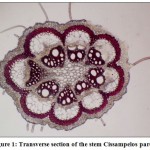 |
Figure 1 Transverse section of the stem Cissampelos pareira.
|
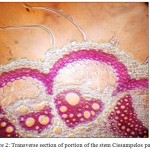 |
Figure 2: Transverse section of portion of the stem Cissampelos pareira.
|
Leaf
It is dorsi-ventral. Stomata are of anomocytic type, present on lower surface. Upper surface is practically free from stomata. Epidermal cells have wavy walls. A single layer of palisade is present below upper epidermis. Mesophyll consists of parenchymatous cells. Leaf bears bicellular covering trichomes. The midrib region shows collenchymatous cells beneath both epidermal layers. The central region is occupied by vascular bundle. The phloem is present on dorsal side and radiating medullary traverses these cells (Fig. 3 and Fig. 4).
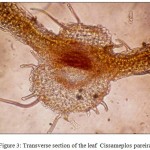 |
Figure 3: Transverse section of the leaf Cissameplos pareira.
|
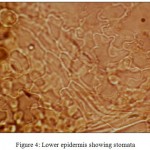 |
Figure 4: Lower epidermis showing stomata.
|
Trichomes
Trichomes are bicellullar with the length upto 360 micron (Fig. 5).
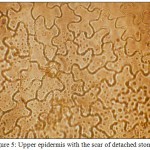 |
Figure 5: Upper epidermis with the scar of detached stomata. |
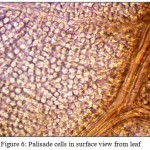 |
Figure 6: Palisade cells in surface view from leaf.
|
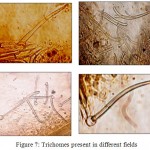 |
Figure 7: Trichomes present in different fields.
|
Conclusion
The present study on pharmacognostical characters of Cissampelos pareira will be useful to supplement information for identification and authentication of the plants.
References
- G. Amresh, G.D. Reddy, Ch.V. Rao, P.N. Singh. Evaluation of anti-inflammatory activity of Cissampelos pareira root in rats. Journal of Ethnopharmacology. 110 : 526–531 (2007).
- Warrier PK, Nambier VP and Ramankutty C: Indian Medicinal Plants – A Compendium of 500 species, Vol. V. Chennai, Orient Longman Pvt Ltd, pp. 138-140 (2005)
- Irama Ramirez, Alfredo Carabot, Pabo Melendoz, Juan Carmona, Manual Jimenez, Asmita V Patel et al. Cissampeloflavone, a chalcone-flavone dimer from Cissampelos pareria. Phytochemistry 64: 645-647 (2003).
- Ahmad, R., Malik, M.A., M., Alkaloids of Cissampelos pareira. Fitoterapia. 63;282-286 (1994).
- Iyengar, M.A., and Nayak, S.G.K., “Anatomy of Crude Drugs” 8th edition (1979).
- Kokate. C.K., Practical Pharmacognosy, Vallabh Prakashan, 3rd Edn., New Delhi, 107-111; 123-125 (1991).

This work is licensed under a Creative Commons Attribution 4.0 International License.





